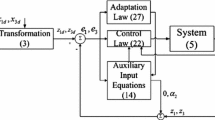Abstract
In this paper, fuzzy-backstepping control method is utilized to control quadruped robots. The backstepping control method is inherently a stable control method since its design procedure is based on the Lyapunov stability theory. However, for an acceptable performance of this controller, the feedback gains must be appropriately selected. Using fuzzy systems, these gains are adaptively tuned for best performance of the robot against uncertainties in system parameters, external disturbances, and measurement noises. Next, the stability of the robot is investigated using the Poincaré map stability criterion. This is because the Lyapunov method does not guarantee stability for the periodic systems such as legged robots. The proposed method is simulated on the highly nonlinear equations of a quadruped robot. The performance of the proposed method is compared with the backstepping control to show the importance of fine-tuning the parameters using fuzzy system. The simulating results for a nine-degree-of-freedom quadruped robot show very good performance of the proposed control method, especially against uncertainties in system parameters, external disturbances, and measurement noises, which are common in robots.



















Similar content being viewed by others
References
Hoffmann M, Simanek J (2017) The merits of passive compliant joints in legged locomotion: fast learning, superior energy efficiency and versatile sensing in a quadruped robot. J Bionic Eng 14(1):1–14
Bououdenand S, Abdessemed F (2014) Walking control for a planar biped robot using 0-flat normal form. Robot Auton Syst 62(1):68–80
Karydis K, Poulakakis I, Tanner HG (2017) A navigation and control strategy for miniature legged robots. IEEE Trans Robot 33(1):214–219
Koo IM, Lee TD, Moon YH, Koo J, Park S, Choi HR (2015) Biologically inspired gait transition control for a quadruped walking robot. Auton Robots 39(2):169–182
Na B, Choi H, Kong K (2015) Design of a direct- driven linear actuator for high-speed quadruped robot, Cheetaroid-I. IEEE/ASME Trans Mechatron 20(2):924–933
Shakourzadeh Sh, Farrokhi M (2016) Optimal gait generation for quadruped robots using mesh adaptive direct search. Int J Math Model Numer Optim 7(1):66–82
Tran DT, Koo IM, Lee YH, Moon H, Park S, Koo JC, Choi HR (2014) Central pattern generator based reflexive control of quadruped walking robots using a recurrect neural network. Robot Auton Syst 62(10):1497–1516
Santos PGD, Garcia E, Estremera J (2008) Quadruped locomotion, 1st edn. Springer, Madrid
Zhou J, Wen C (2008) Adaptive backstepping control of uncertain systems, 1st edn. Springer, Berlin
Ibari B, Benchikh L, Reda A, Ahmed-Foitih Z (2016) Backstepping approach for autonomous mobile robot trajectory tracking. Indones J Electr Eng Comput Sci IAES 3:478–485
Wu H, Karkoub M, Hwang C (2015) Mixed fuzzy sliding-mode tracking with backstepping formation control for multi-nonholonomic mobile robots subject to uncertainties. J Intell Robot Syst 79(1):73–86
Nikdel N, Badamchizadeh MA, Azimirad V (2017) Adaptive backstepping control for an n-degree of freedom robotic manipulator based combined state augmentation. Robot Comput Integr Manuf 44:129–143
Wang LJ, Chao W, Tong G (2014) Central pattern generator based gait control for planar quadruped robots. J Shanghai Jiaotong Univ (Sci) 19(1):1–10
Chen X, Watanabe K, Kiguchi K, Izumi K (2002) An art-based fuzzy controller for the adaptive navigation of a quadruped robot. IEEE/ASME Trans Mechatron 7(3):318–328
Marhefka DW, Orin DE, Schmiedeler JP, Waldron KJ (2003) Intelligent control of quadruped gallops. IEEE Trans Mechatron 8(4):446–456
Kazemi H, Majd V, Moghaddam M (2013) Modeling and robust backstepping control of an underactuated quadruped robot in bounding motion. Robatica 31(3):423–439
Shaocheng T, Changying L, Yongming L (2009) Fuzzy adaptive observer backstepping control for MIMO nonlinear systems. Fuzzy Sets Syst 160(19):2755–2775
Chen MY, Lin CS (1995) Measurement of robustness for biped locomotion using linearized Poincaré map. In: IEEE international conference on system, man, and cybernetics: intelligent systems for the 21th century, Vancouver, Canada
Mu X (2004) Dynamics and motion regulation of a five-link biped robot walking in the sagittal plane. Ph.D. thesis, The University of Manitoba, Department of Mechanical and Manufacturing Engineering, Canada
Lewis FL, Abdallah CT, Dawson DN (2004) Control of robot manipulators: theory and practice. Marcel Dekker Inc, New York
Kokotovic PV (1992) The joy of feedback: nonlinear and adaptive. IEEE Control Syst Mag 12(3):7–17
Wang LX (1996) A course in fuzzy systems and control, 2nd edn. Wiley, Hoboken
Grizzle JW, Abba G, Plestan F (2001) Asymptotically stable walking for biped robots: analysis via systems with impulse effects. IEEE Trans Autom Control 46(1):51–64
Morris B, Grizzle JW (2009) Hybrid invariant manifolds in systems with impulse effects with application to periodic locomotion in bipedal robots. IEEE Trans Autom Control 54(8):1751–1764
Westervelt E, Grizzle J, Chevallereau C, Choi J, Morris B (2007) Feedback control of dynamic bipedal robot locomotion (control and automation). CRC Press, Boca Raton
Author information
Authors and Affiliations
Corresponding author
Additional information
Publisher's Note
Springer Nature remains neutral with regard to jurisdictional claims in published maps and institutional affiliations.
Appendix
Appendix
The kinematic equations of the quadruped robot are given below:
where \( l_{i} \) and \( d_{i} \)(\( i = 1, \ldots ,9 \)) are the length and the half of the length of the ith link, respectively, and \( x_{{c_{i} }} \) and \( y_{{c_{i} }} \) are the x–y coordinate of the center of mass of the ith link, respectively.
Rights and permissions
About this article
Cite this article
Shakourzadeh, S., Farrokhi, M. Fuzzy-backstepping control of quadruped robots. Intel Serv Robotics 13, 191–206 (2020). https://doi.org/10.1007/s11370-019-00309-3
Received:
Accepted:
Published:
Issue Date:
DOI: https://doi.org/10.1007/s11370-019-00309-3




